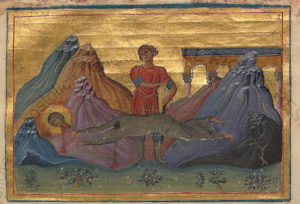The Basics: Born in the 1st century in Israel; died in 117 in Italy; canonized precongregation; feast day, September 4. Martyr.
The Story: Two Roman emperors attempted to break Hermione’s faith, and both failed.
Hermione was one of Philip the Deacon’s (not to be confused with Philip the apostle) four daughters, and so was well grounded in  Christianity. Indeed, she was so well grounded that she and a sister felt a call to seek out John the apostle in present-day Turkey but learned along the way he had died. They then encountered one of Saint Paul’s followers and joined him in his work. Hermione was particularly known as a healer.
Christianity. Indeed, she was so well grounded that she and a sister felt a call to seek out John the apostle in present-day Turkey but learned along the way he had died. They then encountered one of Saint Paul’s followers and joined him in his work. Hermione was particularly known as a healer.
Having heard of her skills–and her faith–Emperor Trajan ordered her to appear before him. In an effort to get her to apostasize, he had her slapped across the face for hours on end. When she remained strong, he then sent her on her way.
Sometime later, Trajan’s successor, Hadrian, made the same attempt, though his tortures were even more sinister, involving unsuccessful attempts to kill her in lead, brimstone, and tar. These efforts only brought about conversions among those charged with guarding her. Finally, she was beheaded.
In 1790, a reliquary with some of Hermione’s remains were brought to Mexico. In September 2018, new non-invasive technology was being used to determine what could be learned about the items, including bone, housed in the reliquary.
What We Can Learn from Hermione: A strong faith foundation, such as the one Hermione and her sisters received from their father, is a true gift as we seek to deepen our relationship with the Lord and prepare for spiritual battle. Is there someone, young or old, who you can help in the way Philip helped his daughters?
To Learn More About Hermione: Read George Poulos’ Orthodox Saints, which includes information about Hermione.
To Learn More About Other Women Saints and Blesseds: Come back next week, or consider buying my book, Sisterhood of Saints: Daily Guidance and Inspiration.